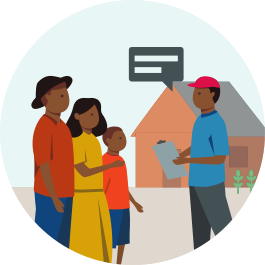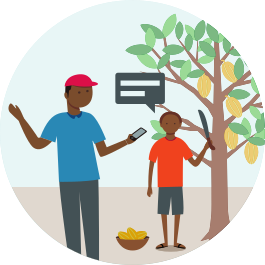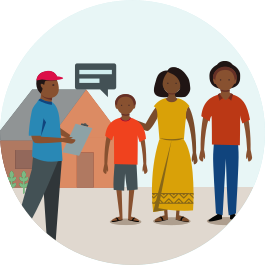
Raising awareness about child labour and the resulting harm amongst farmers, children and the wider community
What we learn from the data
We analyse the types of tasks children report engaging in throughout the year. The data shows that different types of hazardous tasks follow different seasonal patterns.
What we recommend
Awareness-raising campaigns addressing specific hazardous tasks could be scheduled to coincide with their peak seasons, for example:
- application of agro-chemicals (May–June)
- land-clearing tasks (May–July)
- use of sharp tools (July–September).
Adjusting the content of awareness-raising sessions on a seasonal basis could help to increase perceived relevance and prevent awareness-raising fatigue, thus enhancing effectiveness.

Identifying cases of child labourthrough active, regular and repeated monitoring
1. What we learn from the data
We compare child labour identification rates under various CLMRS projects with child labour prevalence rates as measured by survey research. While some systems are reasonably effective at identifying a significant proportion of child labourers, there is still room for improvement. Most monitoring systems are not likely to capture all cases among monitored households.
What we recommend
Continued efforts should be made to revise and improve protocols for monitoring visits, data collection tools, messaging around monitoring objectives and training and support for monitoring agents, to minimise under-identification.
2. What we learn from the data
We find important discrepancies between CLMRS projects with respect to the number of hours children report working per week. This most likely reflects differences in data collection tools, interview techniques and enumerator training.
What we recommend
Obtaining adequate estimates from children concerning the number of hours worked on specific tasks is challenging. CLMRS implementers should therefore:
- ensure that data collection tools, interview techniques and enumerator training follow best practice guidance on survey techniques with children (e.g. https://childethics.com/ethical-guidance)
- use short recall periods (maximum one week) for questions relating to the time spent on certain activities
- schedule sufficient time in each monitoring interview to go through questions about the tasks the children engage in, recognising how difficult it can be for them to accurately estimate time spans
- use a simplified module to estimate work intensity for children below 10 years of age
3. What we learn from the data
Cases of child labour in the cocoa industry are identified year-round, but the data reveals that there are periods of the year when child labour identification rates increase, notably during the peak harvest season (October to January) and during school holidays.
What we recommend
In order for systems to detect a high share of child labour cases, monitoring visits could be intensified during certain periods of the year, notably:
- during peak harvest season
- during or just after school holidays
Monitoring agents and other staff involved in the management of CLMRS should be informed about these typical seasonal patterns in child labour identification. This will allow them to adjust their operational strategies and activity planning.
4. What we learn from the data
Under most CLMRS, agents visit farmers at home to conduct interviews about the participation of children in farm work. In some systems, these home visits are supplemented by random visits to cocoa farms to check on-site for cases of child labour. We find that farm visits frequently lead to the identification of children living in the household, who were absent at the time of the home visit and not mentioned by the parents, as well as of children not living in the farmer’s household.
What we recommend
CLMRS should use a combination of household visits and farm visits to increase the likelihood that all cases of child labour are identified and can be addressed. Farm
visits provide an important additional layer of monitoring, particularly when it comes to ensuring that children not living in the farmer’s household (e.g. children working on their relatives’ or neighbours’ farms) do not fall through the cracks.
5. What we learn from the data
In any monitoring system, the agents in charge of data collection play a crucial role in producing some of the most important outcomes. When monitoring visits are conducted by locally based monitoring agents, we find that agents with specific profiles have a higher likelihood of identifying cases of child labour; notably:
- female agents identify more cases than male agents per number of visits
- agents with higher education levels identify more cases per number of visits than those with primary education only
- with experience, agents become better at identifying cases of child labour
- agents identify fewer cases per number of visits, the more farmers they are required to cover
- agents identify slightly more cases of child labour per number of visits outside of their own communities than within them
What we recommend
For systems that hire locally based agents, it is recommended to:
- set secondary school as a minimum level of education (if sufficient candidates are available)
- make efforts to recruit and retain more female monitoring agents
- incentivise agents to stay on the job after they have acquired experience
- adjust the number of farmers covered by each agent to match the time the agent can dedicate to the job, thus ensuring that each household visit can be completed with due care
- help agents to reach farming households outside of their own community (e.g. by ensuring they have bicycles or motorcycles at their disposal, or by paying transport allowances)

Provision of support (prevention and remediation) to children in child labour and others at risk
1. What we learn from the data
We look at contextual factors which are correlated with the likelihood of a child stopping hazardous work under a CLMRS. The data shows that these systems are better at stopping some children from engaging in hazardous work than others: girls, children who were in school at the time they were identified as participating in child labour, children living with at least one biological parent, children without older siblings and children living in a community with a primary school.
What we recommend
Children with specific profiles are particularly difficult to keep away from hazardous work and therefore should be given extra attention and be the subject of extra effort for remediation, notably:
- out-of-school children, especially when there is no primary school present in their community
- children not living with a biological parent (e.g. children living with relatives or adopted children)
- boys, older children, and children with older siblings.
2. What we learn from the data
We look at how different types of remediation given to child labourers are associated with the likelihood of their stopping hazardous work. First of all, since CLMRS are capable of reducing children’s engagement in hazardous work, the range of remediation provided to children under these systems proves to be effective on the whole. If we compare the different types of remediation, interventions to improve access to and quality of education (e.g. school kits, bridging classes and school renovations) appear to be a particularly promising remediation strategy under the systems in place in Côte d’Ivoire.
Other forms of remediation implemented under various systems include birth certificates, vocational training, literacy classes for parents, income generating activity support, setting up savings groups, VSLAs and community service groups. The data also suggests that birth certificates, school improvements, bridging classes, tutoring and awareness-raising might be more effective for girls than for boys (at least in the context of ICI-implemented systems in Côte d’Ivoire), while school improvements might be more effective for younger children.8
What we recommend
In light of preliminary results concerning the effectiveness of different types of remediation, CLMRS should scale up their interventions to improve access to quality education in order to help children stop hazardous work. In order to inform cost-benefit analyses of the effectiveness of different remediation types, more solid evidence is needed about the kind and magnitude of the impact of the various types of remediation. Experimental research and the careful analysis of additional data from follow-up visits to remediated children should be conducted, in order to make the evidence base more robust.
3. What we learn from the data
We look at how different types of school-related remediation given to out-of-school children in child labour are associated with the likelihood that these children start attending school. Results suggest that the provision of school kits and school uniforms is a promising strategy for increasing school participation amongst child labourers covered by CLMRS in Côte d’Ivoire. Different types of remediation produce different results, depending on which outcome we look at.
Types of remediation which appear less effective at keeping children away from hazardous work may be effective at increasing school participation and vice versa.
What we recommend
According to preliminary results, CLMRS should scale up the provision of school kits and school uniforms, which can help to overcome some of the financial barriers to school attendance for poor households and thereby increase school participation amongst child labourers. Remediation planning should also take into account the effectiveness of different forms of remediation in relation to different objectives. For example, types of remediation that are less effective at stopping children from engaging in hazardous work may facilitate school participation, leading to better learning and development outcomes. However, these broader outcomes lie beyond the scope of the data collected from the monitoring systems.

Following up with children identified as participating in child labour and monitoring their status
1. What we learn from the data
Of the children identified as participating in hazardous child labour, who were interviewed under ICI-implemented CLMRS in Côte d’Ivoire:
- 38% reported no longer performing hazardous tasks during their first follow-up visit.
- 54% reported no longer performing hazardous tasks during one of a series of follow-up visits.
- 29% reported no longer performing hazardous tasks after two consecutive follow-up visits.
What we recommend
Standardised, precisely defined indicators should be used to determine the effectiveness of a given CLMRS at reducing children’s exposure to hazardous work.
2. What we learn from the data
CLMRS can help not only to identify whether a child is engaged in child labour or not, but also the extent of their exposure to hazards. Under the ICI-implemented systems in Côte d’Ivoire, children who continue to engage in hazardous work are exposed to fewer different types of hazard when follow-up visits are conducted (on average, child labourers report exposure to two different hazards; 23% of follow-up visits recorded a decrease in hazards, while 19% of visits recorded an increase in hazards). On average, however, there was no reduction in the length or frequency of work (child labourers aged 10+ monitored by ICI-implemented systems in Côte d’Ivoire work on average 3.2 hours on a working day, 3 days a week).
What we recommend
CLMRS should track the evolution of the severity of child labour among children who continue working. Severity can be measured in terms of the different types of hazards they are exposed to or in terms of working time. These indicators provide a means of assessing whether the situation is improving or worsening.
3. What we learn from the data
The sequences of visits to individual children represent a valuable data source for understanding the dynamics of child labour in the context of monitoring systems in the cocoa industry. The data shows that children who appear to be out of child labour during one visit may be found participating again in child labour when visited a few months later. Among all child labourers who at one point reported no longer performing hazardous tasks, 24% reported performing hazardous tasks again during a subsequent visit.
What we recommend
Monitoring systems should verify through at least two follow-up visits that a child has stopped hazardous work after having received remediation support. We recommend continuing to follow up with children until they no longer report having engaged in hazardous child labour for at least two follow-up visits, with a minimum three-month interval between the visits. The data suggests that after this point, the risk of a child falling back into hazardous child labour is reduced to 16%.
4. What we learn from the data
In addition to addressing child labour, CLMRS aim to improve children’s access to several fundamental rights, including to quality education. Under ICI-implemented systems in Côte d’Ivoire, around one in four out-of-school child labourers began attending school. This shows that these systems are effective not only at reducing children’s participation in child labour, but also at getting children back into school.
What we recommend
Children who both participate in child labour and do not attend school are particularly vulnerable and should be prioritised to receive support. Monitoring and remediation systems should identify improved access to quality education as a central objective and indicator, as well as developing strategies to further improve the effectiveness of support related to education.
References
8 All the results concerning the effectiveness of different types of remediation are purely descriptive, because remediation is allocated to children based on their specific needs and profiles.
